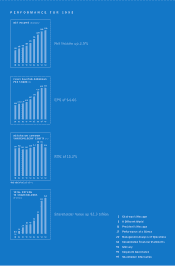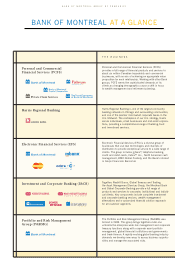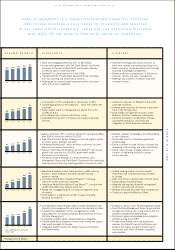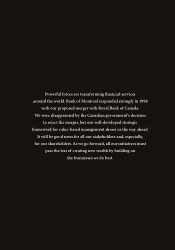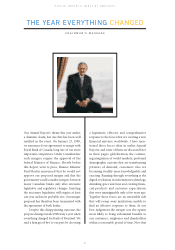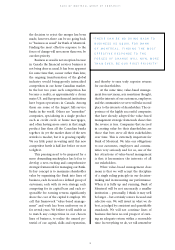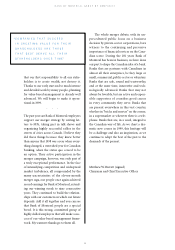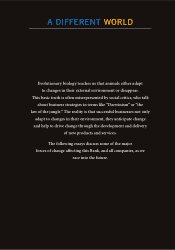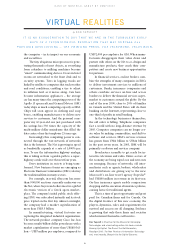Bank of Montreal 1998 Annual Report Download - page 7
Download and view the complete annual report
Please find page 7 of the 1998 Bank of Montreal annual report below. You can navigate through the pages in the report by either clicking on the pages listed below, or by using the keyword search tool below to find specific information within the annual report.
3
BANK OF MONTREAL GROUP OF COMPANIES
the decision to reject the merger has been
made, however, there can be no going back
to “business as usual” for Bank of Montreal.
Finding the most effective response to the
forces of change will now, more than ever, be
our first priority.
Business as usual is not an option because
in Canada the financial services business is
not being done as usual. It has been apparent
for some time that, sooner rather than later,
the ongoing transformation of the global
industry would bring greatly intensified
competition in our home Canadian market.
In the last two years such competition has
become a reality, as approximately a dozen
major U.S. and European financial institutions
have begun operations in Canada. Among
them are some of the largest full-service
banks in the world. Others are “monoline”
companies, specializing in a single product
such as credit cards or home mortgages,
and often having more assets in that single
product line than all the Canadian banks
together. As yet the market share of the new
arrivals is modest, but it is growing rapidly.
We see little point in waiting until this new
competitive battle is half-lost before we start
to fight it.
This pressing need to be prepared for a
more demanding marketplace has led us to
develop a new, exciting and comprehensive
strategic framework for managing our Bank.
Its key concept is to maximize shareholder
value by organizing the Bank into lines of
business, each focused on a defined group of
customers, each with its own strategy, each
competing for its capital base and each re-
sponsible for earning returns significantly
above the cost of the capital it employs. We
call this framework “value-based manage-
ment” and work has been underway on it
for several years. We believe it will enable us
to match any competition in our chosen
lines of business, to realize the unused po-
tential
of our capital, skills and reputation,
and thereby to earn truly superior returns
for our shareholders.
At the same time, value-based manage-
ment does not mean, as is sometimes thought,
that the interests of our customers, employees
and the communities we serve will take second
place to the interests of shareholders. The
ex-
perience
of the highly successful companies
that have already adopted the value-based
management strategic framework shows that
the reverse is true. Companies that succeed
in creating value for their shareholders are
those that best serve all their stakeholders
over time. This is extremely important for
Bank of Montreal. We take our obligations
to our customers, employees and commu-
nities very seriously and for us, one of the
key attractions of value-based management
is that it harmonizes the interests of all
our stakeholders.
What value-based management does
mean is that we will accept the discipline
of a single ruling principle in our decision-
making and in measuring our performance.
When it is fully up and running, Bank of
Montreal will be not necessarily a smaller
institution – personally, I think it may well
be larger – but certainly a more focused and
selective one. We will invest in what we do
best, as judged by consistent and quantifiable
standards. We will not continue lines of
business that have no real prospect of earn-
ing an adequate return within a reasonable
time. In everything we do, we will remember
“THERE CAN BE NO GOING BACK TO
BUSINESS AS USUAL FOR BANK
OF MONTREAL. FINDING THE MOST
EFFECTIVE RESPONSE TO THE
FORCES OF CHANGE WILL NOW, MORE
THAN EVER, BE OUR FIRST PRIORITY”


